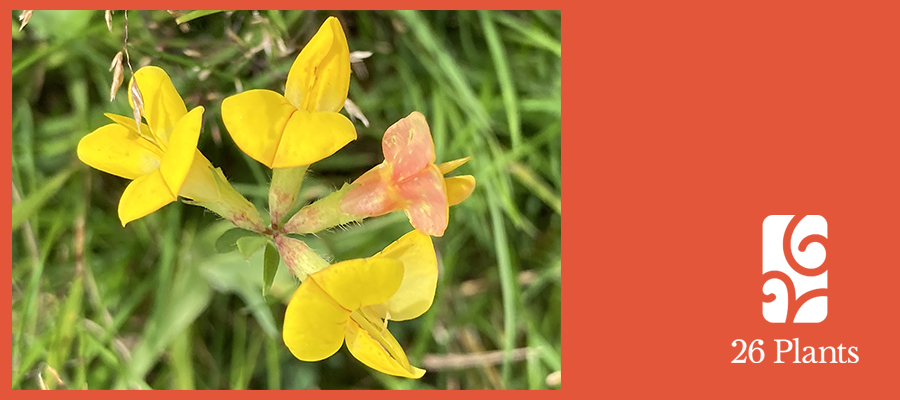Bird’s-foot Trefoil
Lotus corniculatus
Miranda Dickinson

Protector to Protected
Three petals up, two petals down;
By seventy names known.
Lady’s Slippers, Dutchman’s Clogs,
Eggs and Bacon; and its pods
By darker moniker observed:
Granny’s Toenails, Devil’s Claws.
In meadow, grass and clifftop found,
Protection woven in Midsummer wreaths.
In Gothic arches, trinity.
Revenge in Victorian love posies.
A rainbow of visitors attend its blooms:
Wood White, Clouded Yellow, Common Blue,
Dingy Skipper, Green Hairstreak,
Joined by Burnet Moth and Bee.
Yellow trefoil so revered
Is threatened now by ignorance:
Over-grazing and farm advance.
The protector’s mantle
Is thus passed to us, to keep
Two petals down, up petals three.
I began this project with a little knowledge of my plant. My grandpa, who adored wildflowers, called Bird’s-foot Trefoil ‘eggs and bacon’ and was always overjoyed when he found it on one of our walks. Consequently, the journey to get to know this plant better for the 26 Plants project has become a surprisingly personal one because I could imagine Grandpa’s delight at each new discovery!
Bird’s Foot Trefoil (Lotus corniculatus) belongs to the pea family. It’s a creeping perennial with trailing, short stems that can grow up to 35cm high depending on the height of grass around it. Its flowers bloom from the end of April to mid-September and their striking shape of five leaflets (three petals at the top and two at the bottom) have inspired many common names.
I discovered that this small, grassland-loving plant is known by over seventy names across Britain, ranging from Lady’s Slippers and Dutchman’s Clogs to the not-so-attractive Granny’s Toenails and the downright terrifying Devil’s Fingers or Claws. The last two refer to the plant’s black, bird’s-foot-like seed pods. The names suggest both good and evil – a theme that continued the more I learned about Bird’s-foot Trefoil.
Its flowers were woven into wreaths at Midsummer, believed to offer protection against evil. When Christianity arrived, the trefoil became associated with the Trinity, a common motif in Gothic architecture. Meanwhile the Victorian Language of Flowers associated Bird’s-foot Trefoil with revenge.
I loved discovering the literal rainbow of insects the flowers attract, including the rare Clouded Yellow butterfly and the larva of the rare Wood White. Grazing animals, too, find health benefits and protection from the plant, which aids digestion and respiration and combats parasitic infections.
I decided to photograph Birds-foot Trefoil to accompany my centena, so I visited a sloping grassland bank at Hartshill Hayes, Warwickshire. Amid tall grasses, clumps of clover, yarrow and cow parsley, the tiny, vital plants appeared like patches of golden yellow treasure. They are surprisingly small but strikingly beautiful.
With grasslands disappearing across the UK due to over-farming and development, I was struck by the need to protect this plant so synonymous with protection. Now the dark threat comes from humans: but the responsibility for protection is ours, too. I found the idea of us now offering protection to the plant that has traditionally been seen as protecting us a powerful metaphor for the task at hand.
Image: Photograph by Miranda Dickinson
